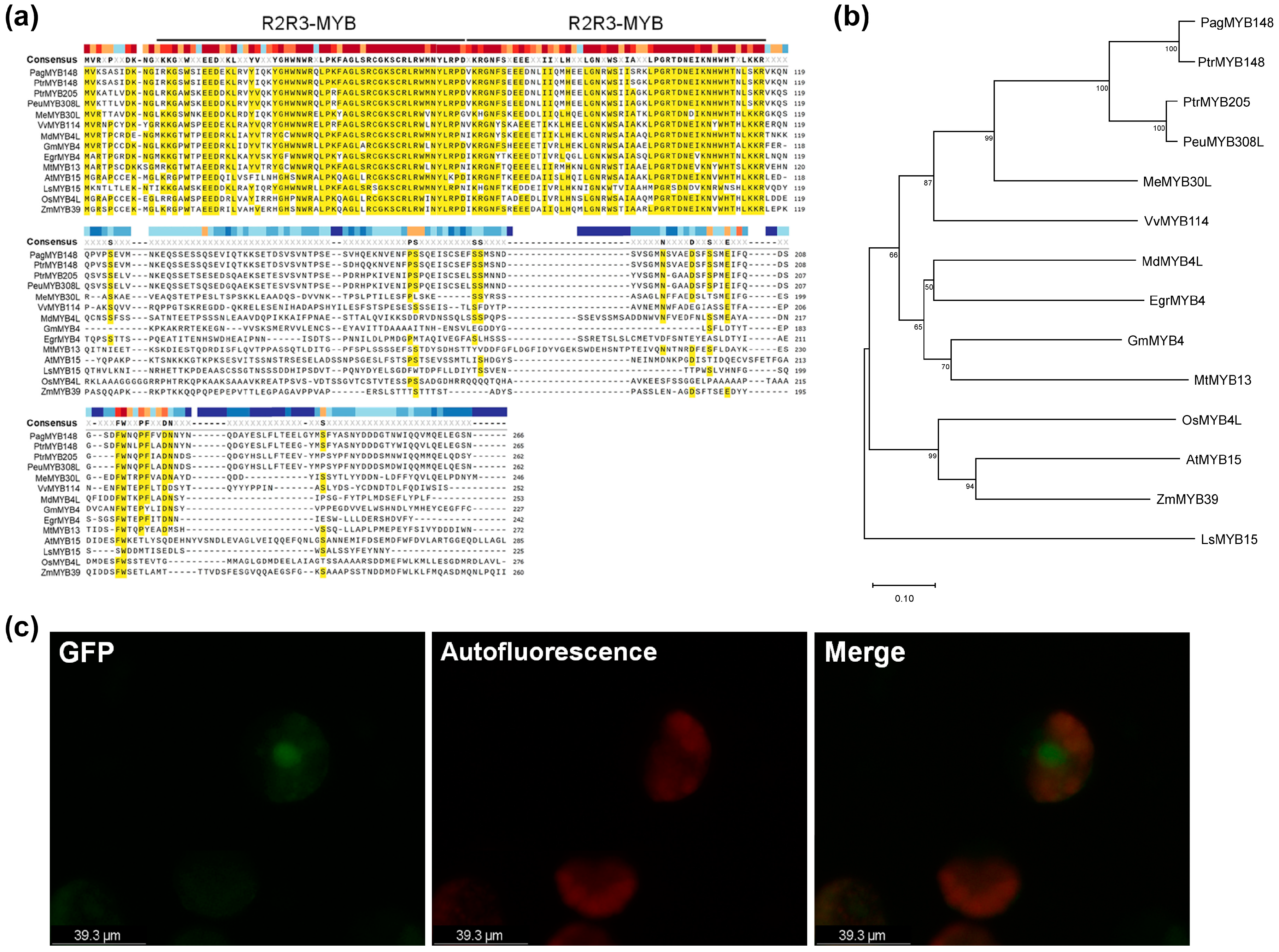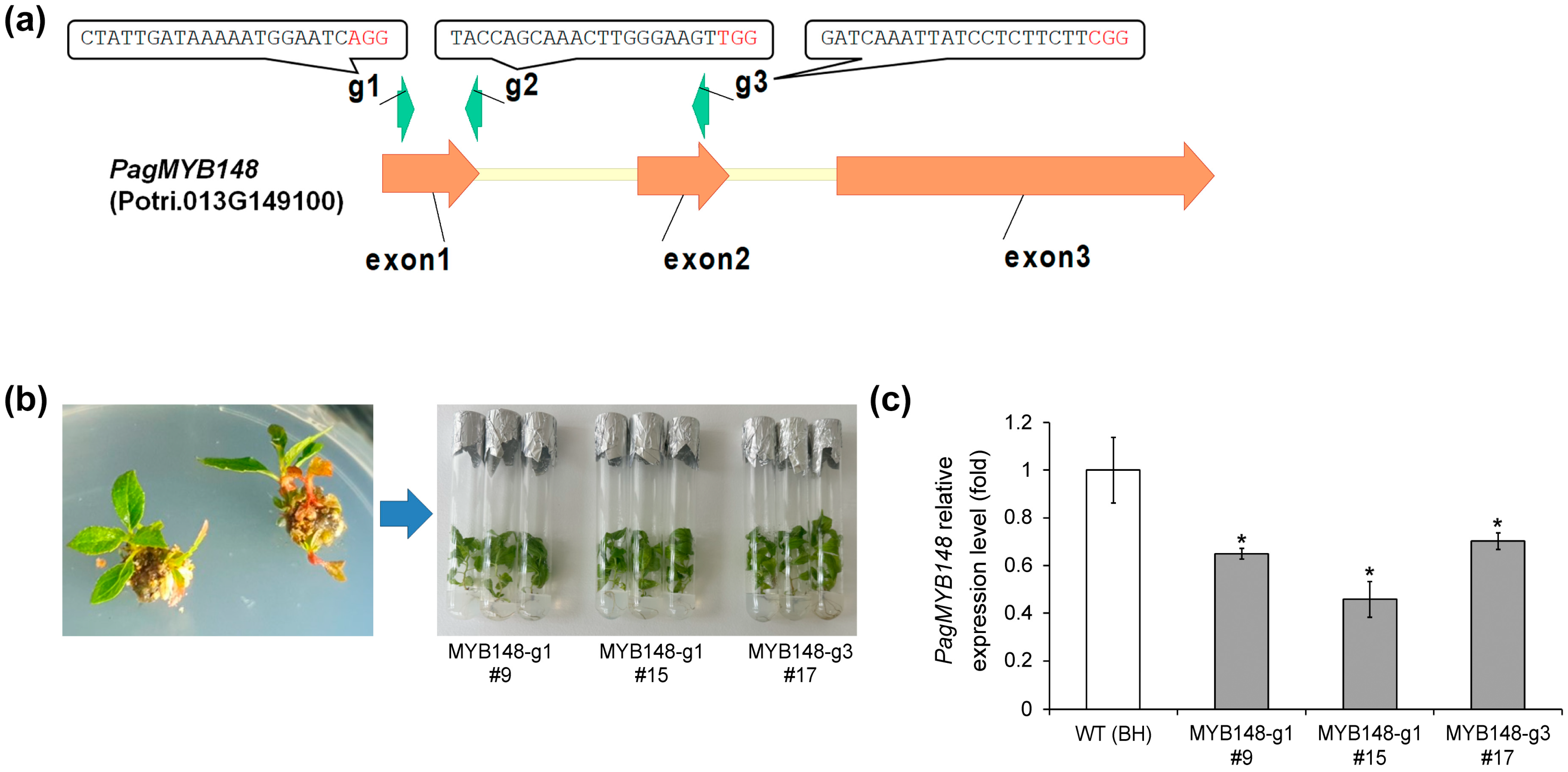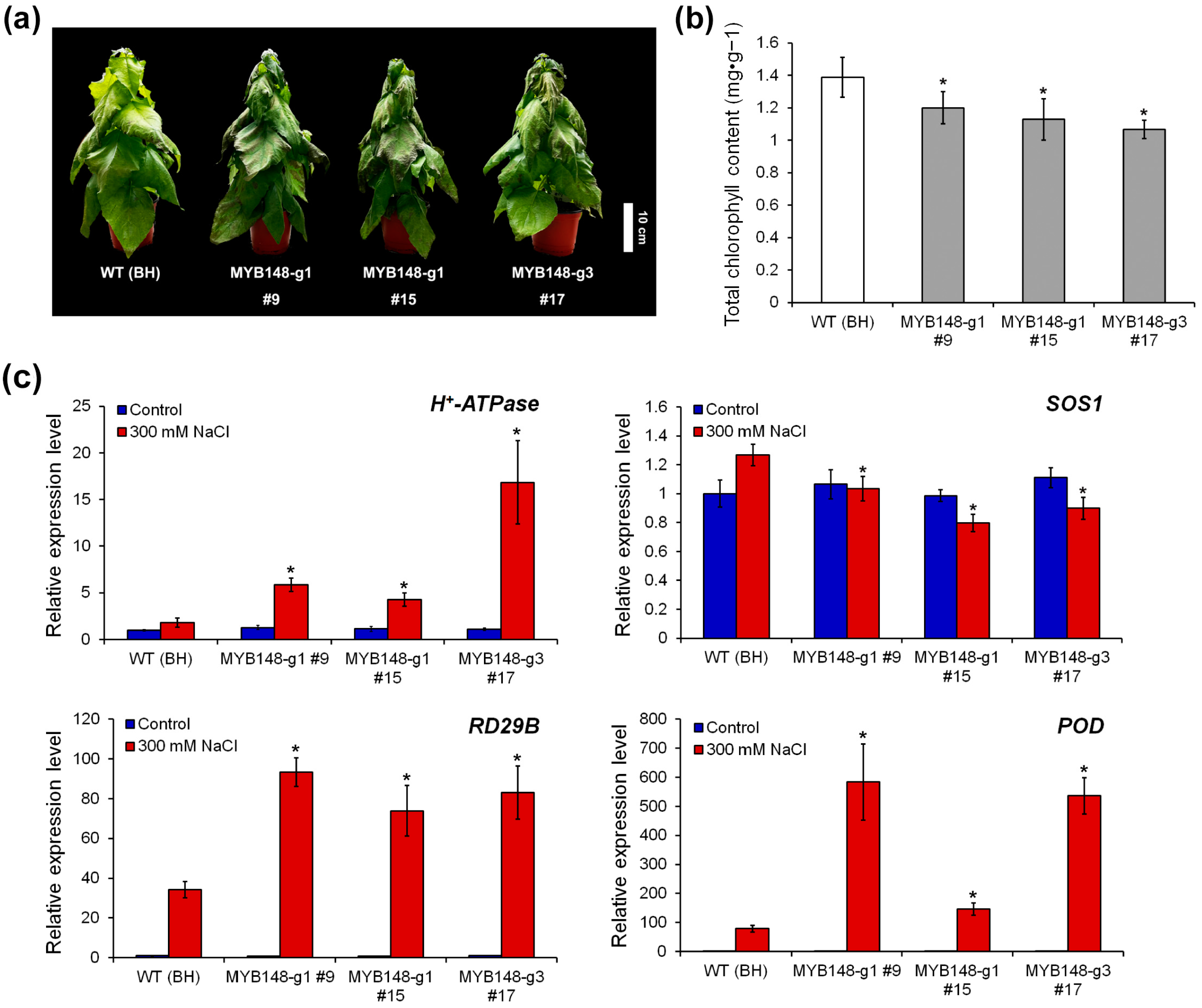Functional Characterization of PagMYB148 in Salt Tolerance Response and Gene Expression Analysis under Abiotic Stress Conditions in Hybrid Poplar
Abstract
:1. Introduction
2. Materials and Methods
2.1. Plant Materials and Growth Conditions
2.2. PagMYB148-CRISPR/Cas9 Vector Construction and Plant Transformation
2.3. Genotyping of Regenerated Transgenic Hybrid Poplars by Targeted Deep Sequencing
2.4. Subcellular Localization of PagMYB148
2.5. RNA Isolation and Reverse-Transcription PCR Analysis
2.6. Stress Treatment
2.7. Determination of H2O2 and Antioxidant Enzyme Activities
2.8. Statistical Analysis
3. Results
3.1. Identification of PagMYB148
3.2. Expression Profile of PagMYB148
3.3. Generation of PagMYB148 Mutants Using CRISPR/Cas9 System
3.4. CRISPR/Cas9-Mediated PagMYB148 Mutants Exhibited Reduced Salt Resistance
3.5. SOD, CAT, and POD Activities in CRISPR/Cas9-Mediated Mutants Exposed to Salt Stress
4. Discussion
4.1. Identification and Generation of CRISPR/Cas9-Mediated Mutagenesis of PagMYB148
4.2. CRISPR/Cas9-Mediated Genome Editing of PagMYB148 Diminished Resistance to Salt Stress
4.3. Disruption of PagMYB148 Reduced Cell Retentivity
5. Conclusions
Supplementary Materials
Author Contributions
Funding
Data Availability Statement
Conflicts of Interest
Abbreviations
| MYB | Myeloblastosis viral oncogene homolog |
| CRISPR | Clustered Regularly Interspaced Short Palindromic Repeats |
| Cas9 | CRISPR-associated protein 9 |
| gRNA | single guide RNA |
| BH | BongHwa |
| WT | Wild type |
| GFP | Green Fluorescence Protein |
| SOD | Superoxide Dismutase |
| POD | Peroxidase |
References
- Hyun, S.K.; Hong, S.C. Inter- and Intra-species hybridization in poplar. Res. Rep. Inst. For. Gen. Korea 1959, 1, 61–73. [Google Scholar]
- Zhang, X.; Liu, L.; Chen, B.; Qin, Z.; Xiao, Y.; Zhang, Y.; Yao, R.; Liu, H.; Yang, H. Progress in understanding the physiological and molecular responses of Populus to salt stress. Int. J. Mol. Sci. 2019, 20, 1312. [Google Scholar] [CrossRef] [PubMed]
- Koo, Y.; Yeo, J. The status and prospect of poplar research in Korea. J. Korea For. Energy 2003, 22, 1–17. [Google Scholar]
- Qiu, D.; Bai, S.; Ma, J.; Zhang, L.; Shao, F.; Zhang, K.; Yang, Y.; Sun, Y.; Huang, J.; Zhou, Y.; et al. The genome of Populus alba × Populus tremula var. glandulosa clone 84K. DNA. Res. 2019, 26, 423–431. [Google Scholar] [CrossRef] [PubMed]
- Jang, H.; Bae, E.; Kim, M.; Park, S.J.; Choi, N.; Pyo, S.; Lee, C.; Jeong, H.; Lee, H.; Choi, Y.; et al. CRISPR-knockout of CSE gene improves saccharification efficiency by reducing lignin content in hybrid poplar. Int. J. Mol. Sci. 2021, 22, 9750. [Google Scholar] [CrossRef] [PubMed]
- Ynag, Y.; Guo, Y. Unraveling salt stress signaling in plants. J. Integr. Plant Biol. 2018, 69, 796–804. [Google Scholar] [CrossRef] [PubMed]
- Wang, S.; Huang, J.; Wang, X.; Fan, Y.; Liu, Q.; Han, Y. PagERF16 of Populus promotes lateral root proliferation and sensitizes to salt stress. Front. Plant Sci. 2021, 12, 669143. [Google Scholar] [CrossRef] [PubMed]
- Li, P.; Li, X.; Jiang, M. CRISPR/Cas9-mediated mutagenesis of WRKY3 and WRKY4 function decreases salt and Me-JA stress tolerance. Mol. Biol. Rep. 2021, 48, 5821–5832. [Google Scholar] [CrossRef] [PubMed]
- Hu, J.; Zou, S.; Huang, J.; Huan, X.; Jin, X.; Zhou, L.; Zhao, K.; Han, Y.; Wang, S. PagMYB151 facilitates proline accumulation to enhance salt tolerance of poplar. BMC Genom. 2023, 24, 345. [Google Scholar] [CrossRef]
- Zhang, P.; Wang, R.; Yang, X.; Ju, Q.; Li, W.; Lu, S.; Tran, L.-S.P.; Xu, J. The R2R3-MYB transcription factor AtMYB49 modulates salt tolerance in Arabidopsis by modulating the cuticle formation and antioxidant defence. Plant Cell Environ. 2020, 43, 1925–1943. [Google Scholar] [CrossRef]
- Mengiste, T.; Chen, X.; Salmeron, J.; Dietrich, R. The BOTRYTIS SUSCEPTIBLE1 gene encodes an R2R3 MYB transcription factor protein that is required for biotic and abiotic stress responses in Arabidopsis. Plant Cell 2003, 15, 2551–2565. [Google Scholar] [CrossRef]
- Park, M.Y.; Kang, J.Y.; Kim, S.Y. Overexpression of AtMYB52 confers ABA hypersensitivity and drought tolerance. Mol. Cells 2011, 31, 447–454. [Google Scholar] [CrossRef]
- Kim, S.H.; Lam, P.Y.; Lee, M.; Jeon, H.S.; Tobimatsu, Y.; Park, O.K. The Arabidopsis R2R3 MYB transcription factor MYB15 is a key regulator of lignin biosynthesis in effector-triggered immunity. Front. Plant Sci. 2020, 11, 583153. [Google Scholar] [CrossRef] [PubMed]
- Xiao, R.; Zhang, C.; Guo, X.; Li, H.; Lu, H. MYB transcription factors and its regulation in secondary cell wall formation and lignin biosynthesis during xylem development. Int. J. Mol. Sci. 2021, 22, 3560. [Google Scholar] [CrossRef]
- Cong, L.; Ran, F.; Cox, D.; Lin, S.; Barrretto, R.; Habib, N.; Hsu, P.; Wu, X.; Jiang, W.; Marraffini, L.; et al. Multiplex genome engineering using CRISPR/Cas systems. Science 2013, 339, 819–823. [Google Scholar] [CrossRef] [PubMed]
- Ran, F.A.; Hsu, P.D.; Wright, J.; Agarwala, V.; Scott, D.A.; Zhang, F. Genome engineering using the CRISPR-Cas9 system. Nat. Protoc. 2013, 8, 2281–2308. [Google Scholar] [CrossRef]
- Ma, X.; Zhu, Q.; Chen, Y.; Liu, Y.G. CRISPR/Cas9 platforms for genome editing in plants: Developments and applications. Mol. Plant 2016, 9, 961–974. [Google Scholar] [CrossRef]
- Bruegmann, T.; Deecke, K.; Fladung, M. Evaluating the efficiency of gRNAs in CRISPR/Cas9 mediated genome editing in poplars. Int. J. Mol. Sci. 2019, 20, 3623. [Google Scholar] [CrossRef]
- Park, S.; Joung, Y.; Kim, K.; Kim, J.; Koh, H. Gene-edited crops: Present status and their future. Korean J. Breed. Sci. 2019, 51, 175–183. [Google Scholar] [CrossRef]
- Gao, C. Genome engineering for crop improvement and future agriculture. Cell 2021, 184, 1621–1635. [Google Scholar] [CrossRef]
- Bae, E.; Choi, H.; Choi, J.; Lee, H.; Kim, S.; Ko, J.; Choi, Y. Efficient knockout of the phytoene desaturase gene in a hybrid poplar (Populus alba × Populus glandulosa) using the CRISPR/Cas9 system with a single gRNA. Transgenic Res. 2021, 30, 837–849. [Google Scholar] [CrossRef]
- Park, J.; Bae, S.; Kim, J. Cas-Designer: A web-based tool for choice of CRISPR-Cas9 target sites. Bioinformatics 2015, 31, 4014–4016. [Google Scholar] [CrossRef]
- Bae, S.; Park, J.; Kim, J. Cas-OFFinder: A fast and versatile algorithm that searches for potential off-target sites of Cas9- RNA-guided endonucleases. Bioinformatics 2014, 30, 1473–1475. [Google Scholar] [CrossRef]
- Kim, H.; Kim, S.; Ryu, J.; Choi, M.K.; Kweon, J.; Kang, B.; Ahn, H.; Bae, S.; Kim, J.; Kim, J.; et al. A simple, flexible and high-throughput cloning system for plant genome editing via CRISPR-Cas system. J. Int. Plant Biol. 2016, 58, 705–712. [Google Scholar] [CrossRef] [PubMed]
- Choi, Y.; Noh, E.; Han, M.; Lee, J.; Choi, K. An efficient and novel plant selectable marker based on organomercurial resistance. J. Plant Biol. 2005, 48, 351–355. [Google Scholar] [CrossRef]
- Park, J.; Kim, K.; Kim, J.; Bae, S. Cas-Analyzer: An online tool for assessing genome editing results using NGS data. Bioinformatics 2017, 33, 286–288. [Google Scholar] [CrossRef] [PubMed]
- Kim, J.; Kim, Y.; Yeom, M.; Kim, J.; Nam, H. FIONA1 is essential for regulating period length in the Arabidopsis circadian clock. Plant Cell 2008, 20, 307–319. [Google Scholar] [CrossRef] [PubMed]
- Abe, S.; Theologis, A. Transient gene expression in protoplasts of Arabidopsis thaliana. Methods Mol. Biol. 1998, 82, 209–217. [Google Scholar]
- Livak, K.; Schmittgen, T. Analysis of relative gene expression data using real time quantitative PCR and the 2−ΔΔCt method. Methods 2001, 25, 402–408. [Google Scholar] [CrossRef]
- Tong, S.; Wang, Y.; Chen, N.; Wang, D.; Liu, B.; Wang, W.; Chen, Y.; Liu, J.; Ma, T.; Jiang, Y. PtoNF-YC9-SRMT-PtoRD26 module regulates the high saline tolerance of a triploid poplar. Genome Biol. 2022, 23, 148. [Google Scholar] [CrossRef]
- Lee, I.H.; Lee, I.C.; Kim, J.; Kim, J.H.; Chung, E.; Kim, H.J.; Park, S.J.; Kim, Y.M.; Kang, S.K.; Nam, H.G.; et al. NORE1/SAUL1 integrates temperature-dependent defense programs involving SGT1b and PAD4 pathways and leaf senescence in Arabidopsis. Physiol. Plant. 2016, 158, 180–199. [Google Scholar] [CrossRef] [PubMed]
- Jeong, E.; Song, J.; Yu, D.; Kim, M.; Jung, Y.; Kang, K.K.; Park, S.; Cho, Y. Overexpression of and oligopeptide transporter gene enhances heat tolerance in transgenic rice. J. Plant Biotechnol. 2017, 44, 296–302. [Google Scholar] [CrossRef]
- Lee, K.C.; Han, S.K.; Yoon, K.K.; Lee, H.B.; Song, J.M. Effects of NaCl on the growth and physiological characteristics of Crepidiastrum sonchifolium (Maxim.) Pak & Kawano. Korean J. Med. Crop Sci. 2020, 28, 1–8. [Google Scholar]
- Blum, A.; Ebercon, A. Cell membrane stability as a measure of drought and heat tolerance in wheat. Crop Sci. 1981, 21, 43–47. [Google Scholar] [CrossRef]
- Lee, J.; Lee, H.; Wi, S.; Yu, I.; Yeo, K.; An, S.; Jang, Y.; Jang, S. Enhancement of growth and antioxidant enzyme activities on Kimchi cabbage by melatonin foliar application under high temperature and drought stress conditions. Hortic. Sci. Technol. 2021, 39, 583–592. [Google Scholar] [CrossRef]
- Park, A.; Lee, Y.; Kang, N.; Kang, D.; Heo, S. Antioxidant efficacy of Jeju crop extracts using Jeju lava seawater as a solvent. J. Plant Biotechnol. 2022, 49, 347–355. [Google Scholar] [CrossRef]
- Mader, M.; Paslier, M.; Bounon, R.; Bérard, A.; Rampant, P.; Fladung, M.; Liplé, J.; Kersten, B. Whole-genome draft assembly of Populus tremula × P. alba clone INRA 717-1B4. Silvae Genet. 2017, 65, 74–79. [Google Scholar] [CrossRef]
- Berta, M.; Giovannelli, A.; Caparrini, S.; Racchi, M.L. Expression of antioxidant genes in relation to water deficit in cambium and leaves of poplar. J. Plant Interact. 2005, 1, 223–227. [Google Scholar] [CrossRef]
- Zhao, Y.; Xin, D.; Lu, W.; Zong, X.; Niu, Y.; Guo, X.; Ma, Y.; Qiang, W.; Su, H.; Zhang, S.; et al. PeMPK7 is induced in an ROS-dependent manner and confers poplar para-hydroxybenzoic acid stress resistance through the removal of ROS. Ind. Crops Prod. 2022, 182, 114861. [Google Scholar] [CrossRef]
- Harfouche, A.; Meilan, R.; Altman, A. Molecular and physiological responses to abiotic stress in forest trees and their relevance to tree improvement. Tree Physiol. 2014, 34, 1181–1198. [Google Scholar] [CrossRef]
- Hao, S.; Wang, Y.; Yan, Y.; Liu, Y.; Wang, J.; Chen, S. A review on plant responses to salt stress and their mechanisms of salt resistance. Horticulturae 2021, 7, 132. [Google Scholar] [CrossRef]
- Agarwal, M.; Hao, Y.; Kapoor, A.; Dong, C.; Fujii, H.; Zheng, X.; Zhu, J. A R2R3 type MYB transcription factor is involved in the cold regulation of CBF genes and in acquired freezing tolerance. J. Biol. Chem. 2006, 281, 37636–37645. [Google Scholar] [CrossRef] [PubMed]
- Ding, Z.; Li, S.; An, X.; Liu, X.; Qin, H.; Wang, D. Transgenic expression of MYB15 confers enhanced sensitivity to abscisic acid and improved drought tolerance in Arabidopsis thaliana. J. Genet. Genom. 2008, 36, 17–29. [Google Scholar] [CrossRef] [PubMed]
- Chen, L.; Xu, M.; Liu, C.; Hao, J.; Fan, S.; Han, Y. LsMYB15 regulates bolting in leaf lettuce (Lactuca sativa L.) under high-temperature stress. Front. Plant Sci. 2022, 13, 921021. [Google Scholar] [CrossRef] [PubMed]
- Liu, H.; Yu, Z.; Fan, G.; Zheng, B. Genome-level analysis of BpR2R3-MYB family genes transcribed in seedlings of Betula platyphylla and BpR2R3-MYB15 enhanced flavonoid production. Chem. Biol. Technol. Agric. 2022, 9, 37. [Google Scholar] [CrossRef]
- Vannini, C.; Locatelli, F.; Bracale, M.; Magnani, E.; Marsoni, M.; Osnato, M.; Mattana, M.; Baldoni, E.; Coraggio, I. Overexpression of the rice Osmyb4 gene increases chilling and freezing tolerance of Arabidopsis thaliana plants. Plant J. 2004, 37, 115–127. [Google Scholar] [CrossRef] [PubMed]
- Jiang, H.; Shi, Y.; Liu, J.; Li, Z.; Fu, D.; Wu, S.; Li, M.; Yang, Z.; Shi, Y.; Lai, J.; et al. Natural polymorphism of ZmICE1 contributes to amino acid metabolism that impacts cold tolerance in maize. Nat. Plants 2022, 8, 1176–1190. [Google Scholar] [CrossRef] [PubMed]
- Tirumalai, V.; Swetha, C.; Nair, A.; Pandit, A.; Shivaprasad, P.V. miR828 and miR858 regulate VvMYB114 to promote anthocyanin and flavonol accumulation in grapes. J. Exp. Bot. 2019, 70, 4775–4791. [Google Scholar] [CrossRef] [PubMed]
- Dabravolski, S.A.; Isayenkov, S.V. Evolution of plant Na+-P-type ATPases: From saline environments to land colonization. Plants 2021, 10, 221. [Google Scholar] [CrossRef]
- Ali, A.; Petrov, V.; Yun, D.; Gechev, T. Revisiting plant salt tolerance: Novel components of the SOS pathway. Trends Plant Sci. 2023, 28, 1060–1069. [Google Scholar] [CrossRef]
- Galović, V.; Joseph, M.P.; Pekeč, S.; Vasić, V.; Vasić, S.; Szabados, L. Characterization of abiotic stress-responsive RD29B and RD17 genes in different poplar clones. Topola/Poplar 2020, 206, 13–20. [Google Scholar] [CrossRef]
- Quan, R.; Lin, H.; Mendoza, I.; Zhang, Y.; Cao, W.; Yang, Y.; Shang, M.; Chen, S.; Pardo, J.M.; Guo, Y. SCABP8/CBL10, a putative calcium sensor, interacts with the protein kinase SOS2 to protect Arabidopsis shoots from salt stress. Plant Cell 2007, 19, 1415–1431. [Google Scholar] [CrossRef]
- Zhang, L.; Jiang, X.; Liu, Q.; Ahammed, G.J.; Lin, R.; Wang, L.; Shao, S.; Yu, J.; Zhou, Y. The HY5 and MYB15 transcription factors positively regulate cold tolerance in tomato via the CBF pathway. Plant Cell Environ. 2020, 43, 2712–2726. [Google Scholar] [CrossRef]





| Genotype | Allele | DNA Sequence (5′ → 3′) | Indel | Amino Acid |
|---|---|---|---|---|
| WT (BH) | P. alba | ATGGTCAAATCAGCCTCTATTGATAAAAATGGAATCAGGAAAGGTTCATGGAGTATAGAAGAAGATGAAAAGC | - | -IRKGSWSIEEDEK- |
| P. glandulosa | ATGGTCAAATCAGCCTCTATTGATAAAAATGGAATCAGGAAAGGTTCATGGAGTATAGAAGAAGATGAAAAGT | - | -IRKGSWSIEEDEK- | |
| MYB148-g1 #9 | P. alba | ATGGTCAAATCAGCCTCTATTGATAAAAATGG–ATCAGGAAAGGTTCATGGAGTATAGAAGAAGATGAAAAGC | –1 bp | -SGKVHGV--- |
| P. glandulosa | ATGGTCAAATCAGCCTCTATTGATAAAAATGG–ATCAGGAAAGGTTCATGGAGTATAGAAGAAGATGAAAAGT | –1 bp | -SGKVHGV--- | |
| MYB148-g1 #15 | P. alba | ATGGTCAAATCAGCCTCTATTGATAAAAATGGATATCAGGAAAGGTTCATGGAGTATAGAAGAAGATGAAAAGC | +T Ins | -YQERFMEYRRR-- |
| P. glandulosa | ATGGTCAAATCAGCCTCTATTGATAAAAATGGATATCAGGAAAGGTTCATGGAGTATAGAAGAAGATGAAAAGT | +T Ins | -YQERFMEYRRR-- | |
| WT (BH) | P. alba | ATGGATGAACTATCTCCGGCCGGACGTAAAGCGAGGAAATTTCTCCGAAGAAGAGGATAATTTGATCATTCAAATGCATG | - | -FSEEEDNL- |
| P. glandulosa | ATGGATGAACTATCTCCGGCCAGACGTAAAGCGAGGAAATTTCTCCGAAGAAGAGGATAATTTGATCATTCAAATGCATG | - | -FSEEEDNL- | |
| MYB148-g3 #17 | P. alba | ATGGATGAACTATCTCCGGCCGGACGTAAAGCGAGGAAATTTCTCCGAA–AAGAGGATAATTTGATCATTCAAATGCATG | –1 bp | -FSEKRII-- |
| P. glandulosa | ATGGATGAACTATCTCCGGCCAGACGTAAAGCGAGGAAATTTCTCCGAA–AAGAGGATAATTTGATCATTCAAATGCATG | –1 bp | -FSEKRII-- |
Disclaimer/Publisher’s Note: The statements, opinions and data contained in all publications are solely those of the individual author(s) and contributor(s) and not of MDPI and/or the editor(s). MDPI and/or the editor(s) disclaim responsibility for any injury to people or property resulting from any ideas, methods, instructions or products referred to in the content. |
© 2024 by the authors. Licensee MDPI, Basel, Switzerland. This article is an open access article distributed under the terms and conditions of the Creative Commons Attribution (CC BY) license (https://creativecommons.org/licenses/by/4.0/).
Share and Cite
Park, S.J.; Jang, H.-A.; Lee, H.; Choi, H. Functional Characterization of PagMYB148 in Salt Tolerance Response and Gene Expression Analysis under Abiotic Stress Conditions in Hybrid Poplar. Forests 2024, 15, 1344. https://doi.org/10.3390/f15081344
Park SJ, Jang H-A, Lee H, Choi H. Functional Characterization of PagMYB148 in Salt Tolerance Response and Gene Expression Analysis under Abiotic Stress Conditions in Hybrid Poplar. Forests. 2024; 15(8):1344. https://doi.org/10.3390/f15081344
Chicago/Turabian StylePark, Su Jin, Hyun-A Jang, Hyoshin Lee, and Hyunmo Choi. 2024. "Functional Characterization of PagMYB148 in Salt Tolerance Response and Gene Expression Analysis under Abiotic Stress Conditions in Hybrid Poplar" Forests 15, no. 8: 1344. https://doi.org/10.3390/f15081344






